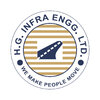Filter interviews by
Hindustan Construction Company Interview Questions and Answers
75 Interview questions
A contour line is a line on a map connecting points of equal elevation above a given level, typically sea level.
Contour lines represent elevation and terrain shape on topographic maps.
They help visualize the steepness of slopes; closely spaced lines indicate steep terrain.
For example, a contour line at 100 meters connects all points that are 100 meters above sea level.
Contour lines can also indicate landforms like...
Underground construction serves various purposes, including space optimization, safety, and environmental protection.
Space Optimization: Underground structures like parking garages maximize land use in urban areas.
Safety: Underground facilities, such as bomb shelters, provide protection from natural disasters and attacks.
Environmental Protection: Tunnels for transportation reduce surface disruption and preserve ec...
Underground construction involves various processes like excavation, support installation, and safety management for structures below ground.
Site Investigation: Assessing soil and rock conditions, e.g., geotechnical surveys.
Excavation: Digging tunnels or shafts using methods like cut-and-cover or boring.
Support Systems: Installing temporary or permanent supports, e.g., steel ribs or shotcrete.
Water Management: Imp...
Fabrication and erection efficiency depends on project scope, manpower, and material handling capabilities.
Typical fabrication output can range from 100 to 500 MT per month, depending on complexity.
Manpower requirements vary; for example, a 200 MT project may need 20-30 skilled workers.
Factors influencing output include equipment availability, worker experience, and project management.
For instance, a well-organize...
I specialize in structural steel fabrication and erection for industrial and commercial projects, ensuring safety and precision.
Fabrication of structural steel components, such as beams and columns, for buildings.
Erection of pre-fabricated elements on-site, ensuring alignment and stability.
Installation of piping systems in industrial plants, ensuring compliance with safety standards.
Use of advanced welding techniq...
Effective manpower management involves strategic planning, clear communication, and continuous monitoring to optimize productivity.
Assess project requirements: Evaluate the scope and complexity of the project to determine the number of workers needed.
Skill matching: Assign tasks based on individual skills and experience to enhance efficiency. For example, a welder should handle welding tasks.
Create a work schedule...
Key tasks in fabrication and erection include planning, quality control, safety management, and effective communication.
Planning: Develop detailed fabrication and erection plans to ensure timely project completion.
Quality Control: Implement rigorous inspection processes to maintain high standards, such as weld inspections.
Safety Management: Prioritize safety protocols to prevent accidents, like using proper PPE an...
LSM (Least Squares Method) minimizes error in data fitting, while WSM (Weighted Sum Method) uses weights for decision-making.
LSM focuses on minimizing the sum of the squares of the errors between observed and predicted values.
WSM aggregates multiple criteria by assigning weights to each criterion based on importance.
Example of LSM: Fitting a line to data points in regression analysis.
Example of WSM: Evaluating pro...
The slump cone test measures the workability and consistency of fresh concrete.
The test involves filling a conical mold with concrete and lifting it to observe the slump.
A higher slump indicates more workability, while a lower slump suggests a stiffer mix.
Typical slump values range from 0 to 10 inches, depending on the application.
For example, a slump of 3-4 inches is suitable for structural concrete, while 5-7 in...
Key aspects of road safety include obeying traffic laws, maintaining vehicle condition, and promoting awareness among drivers and pedestrians.
Obey traffic signals and signs to prevent accidents, e.g., stopping at red lights.
Maintain a safe following distance to allow for sudden stops, e.g., keeping at least three seconds behind the vehicle ahead.
Avoid distractions while driving, such as using a mobile phone or eat...
Hindustan Construction Company Interview Experiences
86 interviews found
I appeared for an interview in Apr 2025, where I was asked the following questions.
- Q1. Work Experience in your field to work in Fabrication/ Erection.
- Ans.
Extensive experience in fabrication and erection, focusing on structural integrity and project efficiency.
Over 10 years of experience in steel fabrication and erection for commercial and industrial projects.
Led a team of engineers in the successful completion of a 500-ton steel structure for a manufacturing facility.
Implemented quality control measures that reduced fabrication errors by 30%, enhancing overall project t...
- Q2. What type of Fabrication or Erection do?
- Ans.
I specialize in structural steel fabrication and erection for industrial and commercial projects, ensuring safety and precision.
Fabrication of structural steel components, such as beams and columns, for buildings.
Erection of pre-fabricated elements on-site, ensuring alignment and stability.
Installation of piping systems in industrial plants, ensuring compliance with safety standards.
Use of advanced welding techniques t...
- Q3. Which one is most achieved by Job in your field?
- Ans.
The most achieved aspect in fabrication and erection engineering is ensuring project efficiency and structural integrity.
Optimizing fabrication processes to reduce costs and time, e.g., using advanced CNC machinery.
Ensuring compliance with safety standards, such as OSHA regulations, to protect workers on-site.
Implementing quality control measures to guarantee structural integrity, like regular inspections during erecti...
- Q4. In Fabrication/Erection in fabricate in MT in one month and how much manpower used.
- Ans.
Fabrication and erection efficiency depends on project scope, manpower, and material handling capabilities.
Typical fabrication output can range from 100 to 500 MT per month, depending on complexity.
Manpower requirements vary; for example, a 200 MT project may need 20-30 skilled workers.
Factors influencing output include equipment availability, worker experience, and project management.
For instance, a well-organized tea...
- Q5. Which is the most important work to do it in Fabrication and Erection.
- Ans.
Key tasks in fabrication and erection include planning, quality control, safety management, and effective communication.
Planning: Develop detailed fabrication and erection plans to ensure timely project completion.
Quality Control: Implement rigorous inspection processes to maintain high standards, such as weld inspections.
Safety Management: Prioritize safety protocols to prevent accidents, like using proper PPE and con...
- Q6. How much In Nuclear Power Project experience. Any queries
- Q7. Any requirement questions about Fabrication and Erection
- Q8. How to handle the manpower and distribution the work.
- Ans.
Effective manpower management involves strategic planning, clear communication, and continuous monitoring to optimize productivity.
Assess project requirements: Evaluate the scope and complexity of the project to determine the number of workers needed.
Skill matching: Assign tasks based on individual skills and experience to enhance efficiency. For example, a welder should handle welding tasks.
Create a work schedule: Dev...
- Q9. Given the position for Fabrication/Erection how can be handled the job and Billing the sub contractors.
- Q10. Any relevant questions about my introduction
I applied via Walk-in and was interviewed in Aug 2024. There were 2 interview rounds.
(4 Questions)
- Q1. What is thickness of tile
- Ans.
The thickness of a tile can vary depending on the type and size of the tile being used.
Tile thickness typically ranges from 1/4 inch to 3/4 inch.
Larger tiles may have a thicker thickness to support their weight.
Thin tiles are often used for wall applications, while thicker tiles are used for flooring.
Porcelain tiles are usually thicker than ceramic tiles.
- Q2. What is thickness of marble
- Ans.
The thickness of marble can vary depending on the type and purpose, but it is typically between 3/4 inch to 1 1/4 inches.
Marble thickness can range from 3/4 inch to 1 1/4 inches
Thicker marble is often used for countertops and flooring
Thinner marble may be used for wall cladding or decorative purposes
- Q3. Process of flooring.
- Ans.
The process of flooring involves selecting the appropriate materials, preparing the subfloor, laying the flooring material, and finishing with trim.
Selecting the appropriate flooring material based on the location and usage (e.g. hardwood, laminate, tile, carpet)
Preparing the subfloor by ensuring it is clean, level, and dry
Laying the flooring material according to manufacturer's instructions, starting from the center o...
- Q4. Types of tile.and use cement ration in tile.
- Ans.
Types of tiles include ceramic, porcelain, glass, and natural stone. Cement ratio in tile installation varies depending on the type of tile and substrate.
Types of tiles: ceramic, porcelain, glass, natural stone
Cement ratio varies based on tile type and substrate
Ceramic tiles typically require a 1:4 cement to water ratio for installation
Porcelain tiles may need a 1:3 cement to water ratio for proper adhesion
(2 Questions)
- Q1. Prosss of flooring
- Ans.
Flooring process involves selecting materials, preparing the subfloor, installing the flooring, and finishing with trim.
Selecting appropriate flooring material based on budget, durability, and aesthetics (e.g. hardwood, laminate, tile, carpet)
Preparing the subfloor by ensuring it is clean, level, and dry before installation
Installing the flooring by following manufacturer's instructions and using proper tools (e.g. adh...
- Q2. Cement ratio use for flooring
- Ans.
The cement ratio for flooring depends on the type of flooring and the strength required.
The typical cement ratio for standard concrete flooring is 1:2:4 (cement:sand:aggregate)
For high strength flooring, the ratio can be increased to 1:1.5:3
For decorative or polished concrete flooring, a lower water-cement ratio is used to achieve a smoother finish
Interview Preparation Tips
(2 Questions)
- Q1. Technical difficulties
- Q2. Technique & problem handal with safety
Be careful any problem with sefty me & other
Safety is first every work in maintenance & brack down important is safety without safety no work i ignore it
No knowledge work no should bhi try to repair & change
Interview Preparation Tips
I applied via Walk-in and was interviewed in Oct 2024. There was 1 interview round.
(2 Questions)
- Q1. Any requirement of Mechanical Engineer
- Q2. Any requirement for job in your organisation please contact me.
I applied via Approached by Company and was interviewed in Sep 2024. There were 2 interview rounds.
(2 Questions)
- Q1. Tell about your self?
- Ans.
I am a dedicated HSE Engineer with a strong background in ensuring workplace safety and compliance with regulations.
Experienced in conducting safety inspections and audits
Skilled in developing and implementing safety procedures and protocols
Proficient in conducting risk assessments and incident investigations
Strong communication and interpersonal skills for training and educating employees on safety practices
- Q2. Why do you want to leave your current company?
- Ans.
Seeking new challenges and opportunities for growth.
Looking for a new challenge to further develop my skills and knowledge
Interested in exploring new opportunities for career advancement
Seeking a company with a stronger focus on safety and compliance
Want to work in a more dynamic and innovative environment
(2 Questions)
- Q1. Hierarchy of control?
- Ans.
Hierarchy of control refers to a system used to minimize or eliminate hazards in the workplace by prioritizing control measures.
Elimination - removing the hazard completely (e.g. replacing a toxic chemical with a safer alternative)
Substitution - replacing the hazard with a less hazardous alternative (e.g. using a less toxic cleaning product)
Engineering controls - isolating people from the hazard (e.g. installing ventil...
- Q2. Hira Related Questions?
Skills evaluated in this interview
I applied via Recruitment Consulltant and was interviewed in Dec 2024. There was 1 interview round.
Process of Goods receive, Material Issuence ,Inventory control ,Gate Pass of Job work Material
Interview Preparation Tips
I applied via Naukri.com and was interviewed in Jan 2024. There were 2 interview rounds.
(3 Questions)
- Q1. What are your exact responsibility in your organization?
- Ans.
As a Quantity Surveyor, I manage costs, contracts, and financial aspects of construction projects to ensure efficiency and profitability.
Conduct cost estimation and budgeting for projects, ensuring accurate financial planning.
Prepare tender documents and analyze bids from contractors to select the best options.
Monitor project progress and expenditures, providing regular financial reports to stakeholders.
Manage contract...
- Q2. What are your additional qualities?
- Q3. AutoCAD, Excel, Friendly with all types of docs , Even the Contract Documents also
- Ans. Maintain good relationship with Clients on the basis of my performance.
(6 Questions)
- Q1. What are work procedure in your organization in RA Bill preparation ?
- Ans.
The work procedure in our organization for RA Bill preparation involves several steps.
Gathering all relevant project documents and information
Analyzing the project scope and specifications
Measuring and quantifying the work done on-site
Preparing detailed rate analysis for each item of work
Calculating the quantities and rates for each item
Preparing the bill of quantities (BOQ)
Cross-checking the BOQ with the project speci...
- Q2. Explain about the different types of bills you know about.
- Ans.
Different types of bills in quantity surveying
Measurement bill: It includes the detailed measurements of various items of work.
Abstract bill: It provides a summary of all the measurements and quantities of work done.
Cost bill: It includes the cost of each item of work and the total cost of the project.
Final bill: It is the final settlement bill after completion of the project.
Interim bill: It is prepared at regular int...
- Q3. Tell me about the importance of contact documents in any type of bill prepation.
- Ans.
Contact documents are essential in bill preparation as they outline the terms and conditions of the contract, provide clarity on project scope, and ensure fair payment for work done.
Contact documents define the legal agreement between the parties involved in a construction project.
They outline the terms and conditions, including project scope, deliverables, timelines, and payment terms.
Contact documents provide clarity...
- Q4. How reconciliation performed?
- Ans.
Reconciliation is performed by comparing and matching financial records to ensure accuracy and consistency.
Reconciliation involves comparing two sets of records, such as bank statements and accounting records, to identify any discrepancies.
The process includes verifying the accuracy of transactions, identifying errors or omissions, and making necessary adjustments.
Reconciliation can be performed manually or using softw...
- Q5. What are the client instructions in your current project about document controlling?
- Ans. As according to client, we have prepare and submit all the prepour and postpour docs with all test certificate if any even in mechanical or civil works before submission of Monthly RA bill.
- Q6. Do you know AutoCAD & Excel well ?
- Ans.
Yes, I am proficient in AutoCAD and Excel.
I have extensive experience using AutoCAD for creating and editing technical drawings.
I am skilled in using Excel for data analysis, calculations, and creating spreadsheets.
I have successfully completed projects where I utilized both AutoCAD and Excel.
I am familiar with the various features and functions of both software.
I can efficiently generate quantity take-offs and cost es...
Interview Preparation Tips
Skills evaluated in this interview
- Q1. Are you able to work at any location?
- Ans.
Yes, I am flexible and willing to work at any location to meet project needs and deadlines.
I have previously worked on projects in remote areas, adapting to local conditions.
I understand the importance of being on-site for effective communication and problem-solving.
I am open to relocation if required, as I believe it enhances my professional growth.
For example, I successfully managed a site in a different city, coordi...
- Q2. What is a contour line?
- Ans.
A contour line is a line on a map connecting points of equal elevation above a given level, typically sea level.
Contour lines represent elevation and terrain shape on topographic maps.
They help visualize the steepness of slopes; closely spaced lines indicate steep terrain.
For example, a contour line at 100 meters connects all points that are 100 meters above sea level.
Contour lines can also indicate landforms like hill...
I applied via Company Website and was interviewed in Jul 2024. There was 1 interview round.
(5 Questions)
- Q1. Working time in site work
- Q2. Working time period
- Q3. Som soil survey steel
- Q4. Highway engineering
- Q5. Irrigation Fluid machinces
I applied via Company Website and was interviewed in May 2024. There were 2 interview rounds.
(1 Question)
- Q1. Client Bill Related Question
(1 Question)
- Q1. Client Bill Related Question
Top trending discussions






Hindustan Construction Company Interview FAQs
Some of the top questions asked at the Hindustan Construction Company interview -
The duration of Hindustan Construction Company interview process can vary, but typically it takes about less than 2 weeks to complete.
Tell us how to improve this page.
Hindustan Construction Company Interviews By Designations
- Hindustan Construction Company Site Engineer Interview Questions
- Hindustan Construction Company Civil Site Engineer Interview Questions
- Hindustan Construction Company Senior Civil Engineer Interview Questions
- Hindustan Construction Company Quality Engineer Interview Questions
- Hindustan Construction Company HSE Engineer Interview Questions
- Hindustan Construction Company Lab Incharge Interview Questions
- Hindustan Construction Company QA QC Engineer Interview Questions
- Hindustan Construction Company Mechanical Engineer Interview Questions
- Show more
Interview Questions for Popular Designations
- Site Engineer Interview Questions
- Civil Site Engineer Interview Questions
- Executive Interview Questions
- Team Lead Interview Questions
- Sales Executive Interview Questions
- Graduate Engineer Trainee (Get) Interview Questions
- Associate Software Engineer Interview Questions
- Assistant Manager Interview Questions
- Show more
Overall Interview Experience Rating
based on 83 interview experiences
Difficulty level
Duration
Interview Questions from Similar Companies
Hindustan Construction Company Reviews and Ratings
based on 1.2k reviews
Rating in categories
|
Site Engineer
216
salaries
| ₹2.7 L/yr - ₹7.2 L/yr |
|
Civil Site Engineer
203
salaries
| ₹1.8 L/yr - ₹7.2 L/yr |
|
Mechanical Engineer
48
salaries
| ₹2.4 L/yr - ₹7.2 L/yr |
|
Quantity Surveyor
48
salaries
| ₹3 L/yr - ₹7 L/yr |
|
Manager
47
salaries
| ₹9.7 L/yr - ₹19.5 L/yr |

L&T Construction

Simplex Infrastructures

ITD Cementation India

Ashoka Buildcon
- Home >
- Interviews >
- Hindustan Construction Company Interview Questions













